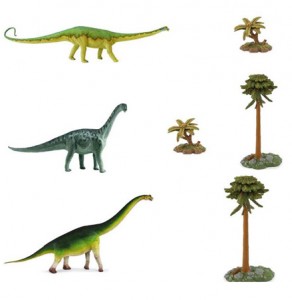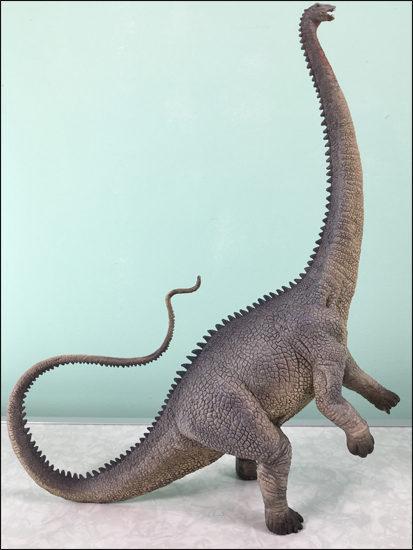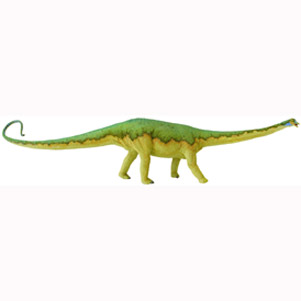Diplodocus Feeding Frenzy – A Biter or a Comber
New Research into Diplodocus Feeding Habits
A team of British scientists have published research that re-affirms the theory that diplodocid dinosaurs such as Diplodocus combed leaves into their mouths rather than biting leaves off branches. Using sophisticated computer based modelling techniques more at home in the aeronautical industry, the research team assessed the stresses on a Diplodocus skull as the animal ate.
New Diplodocid Research
Diplodocus was typical of the diplodocid sauropods. It had a small head, on a long, slender neck and large body supported by four column-like legs. The tails of these giant animals were also very long and slender. Some of the dinosaurs described as diplodocids may have been the longest land animals of all time. The Upper Jurassic strata of the Morrison Formation (western United States), has revealed the fossilised remains of a number of giant, plant-eating dinosaur species, some of which may have exceeded thirty metres in length.
A Typical Model of Diplodocus
Picture credit: Everything Dinosaur
The research team, including members from the Natural History Museum and the School of Earth Sciences at Bristol University, studied the biomechanical stresses imposed on a typical diplodocid skull when different methods of feeding were examined. These large animals were able to consume and process huge amounts of plant matter and very probably spent most of their time eating. Everything Dinosaur team members have calculated that some large individual sauropods may have had to consume plant material equivalent to many thousands of breakfast wheat biscuits per day.
Diplodocus Feeding Habits
The study, reported this week in the scientific publication “Naturwissenschaften” supports an earlier hypothesis that was put forward in the 1990s, that these dinosaurs fed by combing leaves and other plant material off branches and twigs straight into their mouths. The biomechanical tests show that the skull of diplodocids were adapted to strip leaves from trees.
During the Late Jurassic the flora was dominated by ferns, bennettitales, seed ferns (pteridosperms) and cycads. The largest trees tended to be conifers. Flowering plants (the angiosperms), had not evolved and did not evolve until the Early Cretaceous. Palaeontologists have debated which type of plant material these large creatures favoured. Analysis of fossilised dinosaur poo (coprolite) reveals that unsurprisingly, these long-necked dinosaurs were not fussy eaters.
Diplodocids were very efficient “feeding platforms”. An animal could stand in one position and with its long neck it could reach a huge amount of vegetation without moving, a very efficient and energy saving method of gathering food. In addition, dinosaurs like Diplodocus could probably have rocked back onto their hind legs and balanced on their tails (a tripod stance), to enable it to reach up high and feed on the tops of trees. The diplodocids were therefore able to reach parts of the plant canopy that other herbivores did not have access to.
Some of the largest fossils found of dinosaurs relate to the diplodocid clade. Scientists have estimated, for example, that some species of Diplodocus could exceed lengths in excess of twenty-seven metres and weigh more than twenty tonnes.
Diplodocus only had a few, small, peg-like teeth in its jaws. What teeth Diplodocus had were at the front of its jaws and some of these teeth protruded forward. Using a computerised model of a Diplodocus skull, that had been constructed by scanning in three-dimensions Diplodocus skull material, the team were able to build up a picture of the stresses imposed on the skull as the animal ate.
The biomechanical analysis assessed three types of potential feeding behaviour in diplodocids. The model was used to push the skull material to its physical limit helping to determine how much stress the teeth could withstand along with the bones that make up the animal’s head.
One of the problems associated with studying sauropods is that there are no animals alive today that are remotely like them. This complicates any study being made into the feeding habits of these sort of animals. Using finite element analysis (FEA), a methodology used extensively in the design of aeroplanes and orthopaedic devices, the British team concluded that diplodocids probably combed food into the mouths rather than biting off branches.
New Study into the Eating Habits of Diplodocus

Long necks for different feeding envelopes. Different types of sauropod probably fed on differing parts of the canopy. An example of niche partitioning.
Picture credit: Everything Dinosaur
Finite element analysis is just one of a number of techniques being used by palaeontologists to find out more about long extinct creatures. Technology more at home in an engineering plant or a hospital is being used to discover more about dinosaurs and other extinct vertebrates.
The research will furnish one student with a doctorate paper and it provides fresh evidence to support the “leaf-combing” theory postulated by palaeontologists. Some other theories regarding how these animals ate and what food they consumed have been put forward in the past. In the 19th Century and into the early 20th century, many scientists believed that dinosaurs like Diplodocus were almost entirely aquatic, living in lakes and swamps.
These scientists believed that the weak teeth were only suitable for feeding on soft aquatic vegetation such as pond weed. Most palaeontologists now accept that sauropods were almost entirely terrestrial and that they fed exclusively on land plants.
One of the more bizarre theories put forward; postulated that the long necks, small heads in relation to their bodies and peg-like teeth could have been ideal for snatching up shellfish from amongst rocks and off the bottom of lakes and rivers. This theory has largely been discounted, most palaeontologists are comfortable with the hypothesis that these animals were entirely herbivorous.
The research team discovered that whilst the stripping of bark from trees was too stressful for the teeth and likely to result in tooth breakage, combing and raking food into the mouth was no more stressful on the skull as standard biting. This research may help to answer the question how did sauropods feed?
A Diplodocus Dinosaur Model

A rearing Diplodocus dinosaur model in the elephantine colour scheme. Picture credit: Everything Dinosaur.
Picture credit: Everything Dinosaur
The picture (above) shows a CollectA rearing Diplodocus model.
To view the CollectA range of not-to-scale models and figures in stock at Everything Dinosaur: Dinosaur Models (CollectA Age of Dinosaurs – Popular).
An examination of the structure of ferns and indeed extant cycads, suggests that raking food into the mouth would have resulted in a very efficient feeding behaviour. To prove this yourself, take a fork and a fern frond, pull the fork from the base of the frond up to the tip with the prongs of the fork between the rachis (mid-rib). One sharp pull should result in the majority of the vegetation being pulled from the rachis. Everything Dinosaur conduct a similar small group exercise when working with Key Stage 1 children as part of Everything Dinosaur’s school workshops. By doing this you are mimicking the feeding behaviour of one of the largest animals ever to walk the Earth.


